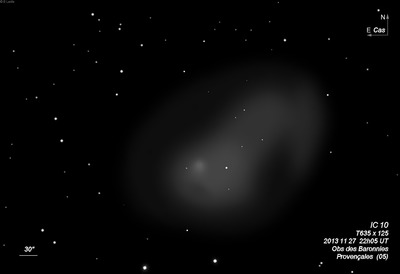
Lewis Swift discovered IC 10 = Sw. VII-1 on 8 Oct 1887 and recorded "F * involved in vL, eeeF nebulosity, eee difficult. In line with 2 stars of equal mag which with a 3rd forms a right angled triangle."
Nicholas Mayall first recognized IC 10 as a galaxy in 1935 ("An Extragalactic Object 3° from the Plane of the Galaxy" in PASP, 47, 317). In 1936, Hubble suggested it might be a member of the local group and called it "One of the most curious objects in the sky" in his 1936 classic "The Realm of the Nebulae." This wasn't confirmed until 1996 using Cepheid variables and the current distance estimate is ~2.5 million l.y. This irregular dwarf galaxy is probably a member of the M31 satellite system and it lies only 3.3 deg from the galactic plane.
300/350mm - 13.1" (11/5/83): very faint, moderately large, elongated NW-SE. Unusually low even surface brightness. A mag 13 star is superimposed near the center. Located in a very rich star field just 3.3° from the galactic plane! Member of the Local Group.
400/500mm - 18" (9/6/10): this local group dwarf Irregular was immediately picked up at 108x (without a printed finder chart) as a large, low surface brightness hazy glow, ~4'x2.5', roughly elongated NW-SE, though the outer extent increased with averted vision and careful viewing. A mag 12.7 star is superposed to the southeast of center and a few stars are on the northwest end. The 1.5' region surrounding the mag 12.7 star is the brightest portion of the galaxy and the W and NW regions have a very low surface brightness and appeared irregular and patchy. Located 12' NE of mag 7.3 HD 486 and just north of a right triangle of mag 10-11 stars
Using 175x, a very small 15" knot was clearly visible about 50" following the mag 12.7 star. This knot is a giant HII region (site of violent starburst formation) catalogued by Hodge and Lee (1990) as HL 111. At 285x with direct vision a faint star at its west edge was similar in visibility, but with averted vision the HII knot was more evident. I probably viewed the brightest component 111c, which has a diameter of 11", of this HII complex. Two mag 10.5 stars 3.5' S and 5.5' S of the galaxy (part of the right triangle mentioned above) provide a useful guide to pinpoint the location of HL 111. The HII region is directly on a line and equally spaced with these stars -- just follow the stars to the small knot.
18" (7/15/07): at 225x this Local Group member (M31 subgroup) appeared faint, fairly large, slightly elongated NW-SE, ~4.5'x3.5', low even surface brightness except fades at the edges. A mag 13 star is superimposed west of center and a fainter star follows. Located 1.4 degrees ENE of mag 2.3 Beta Cas (Caph).
18" (10/8/05): picked up fairly easily at 115x as a large, low surface brightness hazy region with a mag 13 star superimposed. Good view at 160x using the Meade 14mm Ultrawide. Appeared faint, large, slightly elongated, ~4'-5' diameter (though no distinct borders) with a patchy, mottled appearance, very weak concentration. Several faint stars (besides the mag 13 star) are superimposed. Situated within a rich star field and appears similar to a low surface brightness emission or reflection nebula.
Notes by Steve Gottlieb